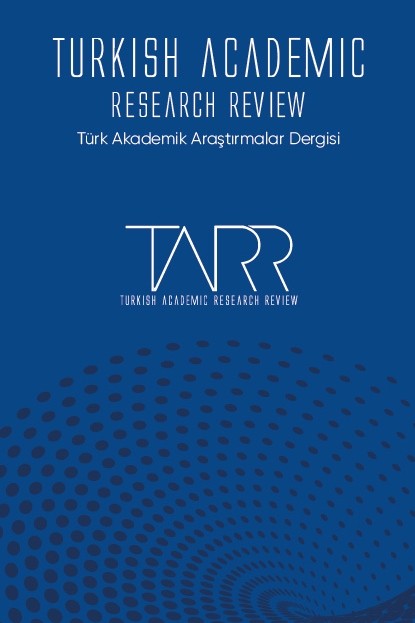Cinuçen Tanrıkorur’un İlâhî Formundaki Bestelerinin Biçim Yönünden Tahlîli
Cinuçen Tanrıkorur 20. yy’da yaşamış önemli bir ud virtüözü, besteci ve müzikologdur. Özgün bestecilik anlayışı ile bestelemiş olduğu 505 adet eseri form özellikleri, makam kullanımları, mûsikî tasvîrleri ve ezgi yapılarıyla diğer bestekârlardan ayrıcalıklı özellikler göstermektedir. Bestelemiş olduğu formlardan bazıları; Mevlevî Âyini, Münâcât, Na‘t, Tevşîh, Durak, Mersiye, İlâhi, Çocuk İlâhisi, Şuğul, Nefes, Peşrev, Saz Semâisi, Medhal, Oyun Havası, Longa, Kâr, Kâr-ı Nâtık, Kârçe, Beste, Ağır Semâi, Yürük Semâi, Fantezi, Şarkı, Destan, Gazel, Ağıt, Türk Film Müziği, Ud Etüdü, Folklorik Etüt, Ninni, Mâni, Çocuk Şarkısı, Marş’tır. Tanrıkorur’un bestelerinde makam, usûl ve seyir bakımından klâsik, geçki ve kompozisyon özellikleri açısından yenilikçidir. Ayrıca bestelerindeki cümleler açık ve net şekilde hissedilmektedir. Bu çalışma, Cinuçen Tanrıkorur’un bestecilik anlayışını, Türk din mûsikîsinin en küçük formu olan ilâhî formu üzerinden ortaya koymayı amaçlamaktadır. İlâhî formunda biçim özelliklerinin nasıl kullandığını tespit etmek çalışmadaki diğer amaçlarımızdandır. Çalışma ayrıca Tanrıkorur’un eserlerindeki cümle, bölüm yapılarını inceleyerek, bestekâra ait bestecilik özelliklerini ortaya koymaktadır. Çalışmanın konusu Tanrıkorur’un bestecilik anlayışını ve ilâhî formu kullanım özelliklerinin tesbîti bakımından önemlidir. Çalışmanın evrenini, Tanrıkorur’un besteleri, örneklemini ise, ilâhî formunda seçilmiş 5 adet bestesi oluşturmaktadır. Çalışmanın yönteminde “Gülçin Yahya Biçim Tahlîli” ve kaynak tarama yöntemleri kullanılmıştır. Cinuçen Tanrıkorur’un seçilen ilâhî formundaki besteleri cümle, bölüm yapıları, eser kurgusu, icra akışı yönleriyle tahlîl edilmiş ve biçim özellikleriyle ortaya konmuştur. İncelenen ilâhîlerde birbirinden farklı bölüm yapılarının kullanıldığı, esere besteci tarafından güfte hâricinde lafızlar ve nakaratlar eklendiği, ezgi yapılarının sâde bir şekilde makāmı anlattığı, bölümlerde mutlaka makam geçkilerini tercih ettiği tesbit edilmiştir.
Anahtar Kelimeler:
Cinuçen Tanrıkorur, İlâhî, Makam, Form, Etkin Perde
The Formal Analysis of Cinuçen Tanrıkorur's Compositions in Hymnal Form
Cinuçen Tanrıkorur was an important oud virtuoso, composer and musicologist who lived in the 20th century. His 505 pieces of work, which he composed with his unique composition understanding, show distinctive features from other composers with their form features, use of maqams, musical descriptions and melodic structures. Some of the forms he composed; Mevlevi Ceremony, Münâcât, Na't, Tevşîh, Durak, Mersiye, İlahi, Children's İlahi, Şuğul, Nefes, Peşrev, Saz Semaisi, Medhal, Traditional dance music, Longa, Kar, Kar-ı Natik, Karçe, Beste, Ağır Semai, Yürük Semâi, Fantasy, Song, Destan, Gazel, Lament, Turkish Film Music, Oud Etude, Folkloric Etude, Lullaby, Mani, Children's Song, March. In Tanrıkorur's compositions, he is classical in terms of maqam, usûl and rhythm, and innovative in terms of transition and composition. In addition, the sentences in his compositions are clearly felt. This study aims to reveal Cinuçen Tanrıkorur's understanding of composition through the ilâhî form, which is the smallest form of Turkish religious music. One of our other purposes is to determine how he uses form features in his ilâhî form. It is one of our other aims of the study to determine how the form features are used in ilahi form. The study also reveals the compositional characteristics of the composer by examining sentence and section structures of Tanrıkorur’s works. The subject of the study is important in terms of determining Tanrıkorur's understanding of composition and the features of using the ilâhî form. The universe of the study consists of Tanrıkorur's compositions, and the sample consists of 5 compositions in ilâhî form. In the method of the study, "Gülçin Yahya Form Analysis" and source scanning methods were used. Cinuçen Tanrıkorur's compositions in the chosen ilâhî form were analyzed in terms of sentence, section structures, playing work fiction, performance flow, and revealed with their form features. It was determined that different section structures were used in the examined ilâhîs, words and refrains were added to the work by the composer in addition to lyrics, that the melody structures simply explained the maqam, and he definitely preferred the makam passages in the chapters.
Keywords:
Cinuçen Tanrıkorur İlahi, Composition, Maqam, Form, Active pitch.,
___
- Akdoğu, O. (1996). Türk Müziğinde Türler ve Biçimler. İzmir: Ege Üniversitesi Basımevi.
- Alvan, T., & Alvan, H. (2016). Saz ve Söz Meclisi "Şiir ve Musıkî Medeniyetimiz". İstanbul: Şule Yayınları.
- Ayverdi, İ. (2010). Misalli Büyük Türkçe Sözlük. İstanbul: Kubbealtı, Bilnet Matbaacılık.
- Belviranlı, Ö. F. (2016, 09 01). Tarihî, kültürel, icrâî, nazarî ve biçimsel yönleriyle Türk Din Mûsikîsinde ilâhî formu nasıldır? (Ç. Toptaş, Röportaj Yapan)
- Demirtaş, Y. (2009). Türk Din Mûsikîsi Formları. Fırat Üniversitesi İlâhîyat Fakültesi Dergisi, 213-227.
- Devellioğlu, F. (2013). Osmanlıca - Türkçe Ansiklopedik Lûgat. Ankara: Aydın Kitabevi.
- Kaçar, G. Y. (2012). Türk Mûsikîsi Rehberi. Ankara: Maya Akademi.
- Kaçar, G. Y. (2020). Türk Mûsikîsinde Eser ve İcrâ Tahlîli Yöntemleri. Ankara: Gece Kitaplığı.
- Kaçar, G. Y., & Aydın, A. (2020). Avşar Bozlağı’na Yapılan Dört Farklı “Açış” İcrâ Örneğinin Motif Tabanlı Biçim Tahlîli. İtobiad, 1779.
- Özalp, N. (1992). Türk Mûsikîsi Beste Formları. Ankara: TRT Müzik Dairesi Başkanlığı.
- Özcan, N. (2011). Tekke Mûsikisi: DİA İslâm Ansiklopedisi. https://islamansiklopedisi.org.tr/: https://islamansiklopedisi.org.tr/tekke-musikisi adresinden alınmıştır
- Öztuna, Y. (1969). Türk Mûsikîsi Ansiklopedisi I. Cilt. İstanbul: Milli Eğitim Basımevi.
- Uludağ, S. (2012). Tasavvuf Terimleri Sözlüğü. İstanbul: Kabalcı Yayınevi.
- Uzun, M. (2000). İlâhi: TDV İslam Ansiklopedisi. TDV İslâm Ansiklopedisi Web Sitesi: https://islamansiklopedisi.org.tr/ilahi adresinden alınmıştır
- Yayın Aralığı: Yılda 4 Sayı
- Başlangıç: 2016
- Yayıncı: Mehmet ŞAHİN
Sayıdaki Diğer Makaleler
Özel Yetenekliler ve Toplumsalın İnşası
Gökhan Veli KÖKTÜRK, Hatice ÜSTÜNER, Aslı YILMAZ, İpek ÖZDEMİR
Baba Rahîm Meşreb Menâkıb-nâmesi’nde Geçen Şiirlerdeki Acem Kaynaklı Mitolojik Şahıslar
İmam Mâturîdî’nin Te’vîl ve Haber Teorilerinin Mukayesesi
Giysi Tasarımlarında “Maraş File Nakışı”
Bilal ŞİMŞEK, Bekir DİREKCİ, Betül KOPARAN
Pîr Muhammed Mevlevî’nin Hazînetü’l-Ebrâr İsimli Eserinin 4. Cildinde Bir Ayetin İrşat Şekli
Cinuçen Tanrıkorur’un İlâhî Formundaki Bestelerinin Biçim Yönünden Tahlîli
Eleştirel Düşünme Eğiliminin Dindarlık Üzerine Etkisi: İlahiyat Fakültesi Öğrencileri Örneği
Ali YÜKSEL, Şeyma Nur KAYACAN, Ahmet ÇAKMAK, Muhammed KIZILGEÇİT
İbn Rüşd’ün Tanrı’ya Cevher Demesinin Neden ve Sonuçları
